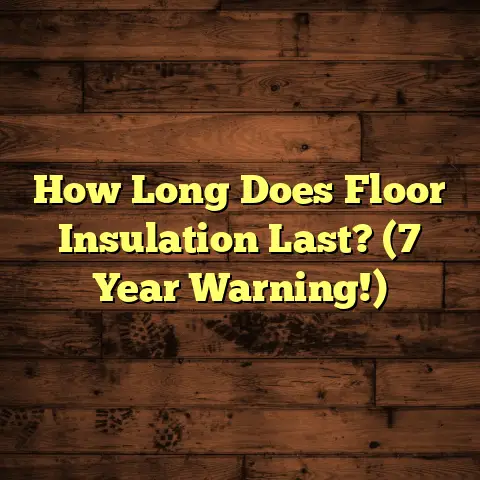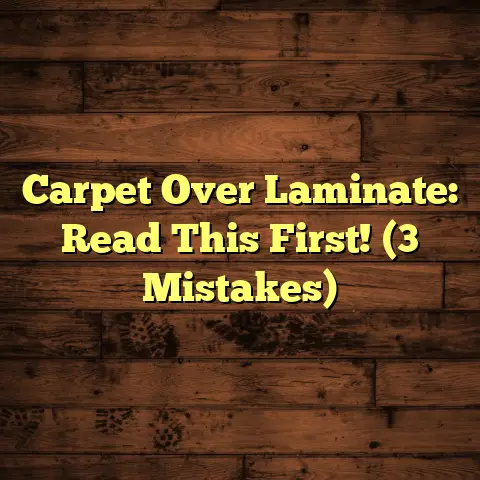Anti-Slip On Laminate? (2 Must Know Risks!)
Here’s your article:
Anti-Slip on Laminate?
(2 Must Know Risks!)
In today’s world, keeping our homes and workplaces safe is super important.
Lots of accidents happen because of slippery floors, and laminate, though nice-looking and easy to care for, can be a culprit.
It’s slippery, especially when wet.
So, everyone wants anti-slip solutions. But hold on!
Before you jump in, you need to know the risks of putting anti-slip stuff on laminate.
I’m going to tell you about two big risks so you can make the right choice to protect your family or customers.
Don’t wait for someone to slip; let’s get you informed now!
1. Introduction to Laminate Flooring
Okay, so what is laminate flooring anyway?
Basically, it’s a layered synthetic flooring that looks like real wood, tile, or stone.
It has a photographic applique layer under a clear protective layer. Think of it like a high-tech, super-durable photograph on your floor.
Why is it so popular?
Well, there are a few reasons:
-
Cost: It’s way cheaper than hardwood or tile.
-
Looks: You can get it in almost any style you want.
-
Easy to Install: DIY-ers love it because it’s usually a click-lock system.
But here’s the thing: laminate can be slippery. I’ve seen it happen too many times.
And slip and fall accidents are no joke.
According to the CDC, millions of people are treated in emergency rooms each year because of falls.
While not all are on laminate, a good chunk are due to slippery surfaces at home.
2. Understanding Anti-Slip Treatments
So, what are these anti-slip treatments everyone’s talking about?
They’re products designed to increase the friction of a surface, making it less slippery.
Think of it like giving your shoes a better grip on the floor.
What are the options?
There are a few different types:
-
Coatings: These are liquids you apply that create a textured surface when they dry.
-
Treatments: These are chemicals that change the surface of the flooring itself.
-
Mats & Rugs: Simple, but effective for high-risk areas.
How do you measure slip resistance?
Good question! There’s something called a “slip resistance rating.”
It’s measured using tests like the Static Coefficient of Friction (SCOF).
A higher SCOF number means less slippery.
Generally, a SCOF of 0.5 or higher is considered safe for level surfaces.
3. Risk 1: Deterioration of Laminate Quality
Okay, this is where it gets serious.
Some anti-slip treatments can actually damage your laminate floor.
I’ve seen it firsthand, and it’s not pretty.
How does this happen?
It’s all about the chemistry.
Laminate flooring is made of layers of different materials, including a fiberboard core and a decorative top layer.
Some anti-slip treatments contain harsh chemicals that can react with these materials.
-
Warping: The chemicals can cause the fiberboard to swell.
-
Discoloration: The decorative layer can fade or change color.
-
Peeling: The layers can start to separate.
Example:
I once worked with a client who used a strong anti-slip cleaner on their laminate.
Within a few months, the floor started to bubble up and the color faded in high-traffic areas.
They had to replace the whole floor!
Long-Term Problems
Even if you don’t see damage right away, some anti-slip treatments can cause problems down the road.
They can weaken the laminate, making it more prone to scratches and dents.
Over time, this can ruin the look of your floor and lower your home’s value.
4. Risk 2: False Sense of Security
This risk is sneaky because it’s about how we think about safety.
Anti-slip treatments can make us feel like our floors are totally safe, even when they’re not.
Why is this a problem?
Because we might stop being careful.
We might run instead of walk, or spill something and not clean it up right away.
And that’s when accidents happen.
I remember a case where a restaurant used an anti-slip coating on their laminate floors.
They thought they were covered, but a customer slipped and fell after someone spilled a drink.
The coating helped, but it wasn’t enough to prevent the accident completely.
What affects anti-slip effectiveness?
Lots of things!
-
Humidity: Moisture can reduce the effectiveness of some treatments.
-
Cleaning Agents: Some cleaners can break down the anti-slip coating.
-
Wear and Tear: Over time, the treatment can wear off, especially in high-traffic areas.
The Psychology of Safety
When we think something is safe, we tend to take more risks.
It’s just human nature.
But with flooring, that can be dangerous.
You need to remember that anti-slip treatments are not a magic bullet.
They’re just one part of a larger safety plan.
5. Conclusion and Call to Action
So, we’ve covered a lot. Laminate is great, but can be slippery.
Anti-slip treatments can seem like a good idea, but they come with risks.
They can damage your floor and give you a false sense of security.
What should you do?
-
Do your research. Read reviews, talk to experts, and understand the risks of any treatment you’re considering.
-
Get professional advice. Talk to a flooring contractor who knows about laminate and anti-slip solutions.
-
Prioritize safety. Think about other ways to reduce the risk of slips and falls, like using rugs, cleaning up spills quickly, and wearing appropriate footwear.
Your safety and the longevity of your floors are worth taking the time to make an informed decision. Don’t rush into anything!





